 Vol.3, No.3, 186-192 (2011) Natural Science http://dx.doi.org/10.4236/ns.2011.33024 Copyright © 2011 SciRes. OPEN ACCESS Longitudinal dispersion with constant source concentration along unsteady groundwater flow in finite aquifer: analytical solution with pulse type boundary condition Mritunjay Kumar Singh1*, Nav Kumar Mahato1, Premlata Singh2 1Department of Applied Mathematics, Indian School of Mines, Dhanbad, India; *Corresponding Author: drmks29@rediffmail.com 2Department of Mathematics, Banaras Hindu University, Varanasi, India; prema.singh@rediffmail.com Received 24 December 2010; revised 25 January 2011, accepted 27 January 2011. ABSTRACT Analytical solution is obtained to predict the con- taminant concentration with presence and ab- sence of pollution source in finite aquifer subject to constant point source concentration. A longi- tudinal dispersion along unsteady groundwater flow in homogeneous and finite aquifer is con- sidered which is initially solute free that is, aq- uifer is supposed to be clean. The constant source concentration in intermediate portion of the aquifer system is considered with pulse type boundary condition and at the other end of the aquifer, concentration gradient is supposed to be zero. The Laplace Transformation Technique (LTT) is used to obtain the analytical solution of the formulated solute transport model with suitable initial and boundary conditions. The time varying velocities are considered. Analyti- cal solutions are perhaps most useful for benchmarking the numerical codes and models. It may be used as the preliminary predictive tools for groundwater management. Keywords: Aquifer; Unsteady Groundwater Flow; Longitudinal Dispersion; Uniform Source Concentration; Pulse Type Boundary Condition 1. INTRODUCTION A large part of the drinking water in India comes from groundwater. The contamination of groundwater systems is still a major issue in the assessment of hazards and risks to public health. The underground systems are very attractive as waste repositories because of the possibility of degradation by biochemical processes. But in some cases, it can lead to contamination of regional ground- water systems. The contaminant releases to groundwater can occur by design, by accident or by negligence. Most of the groundwater contamination incidents involve sub- stances released at or only slightly below the land surface. The transport of contaminants in groundwater is described by solute transport equations in the form of partial dif- ferential equations. These equations are known as solute transport models. These models simulate movement and concentration of various contaminants in groundwater system and can be classified into three categories such as advection models, advection-dispersion models, and ad- vection-dispersion-chemical biological reaction models. Advection models define the movement of contaminant as a result of groundwater flow only. Advection disper- sion models takes into consideration molecular diffusion, and microscopic/macro dispersion. Advection-dispersion- chemical biological reacion models include the effect of chemical or biological reactions which change the con- centration of transported contaminants [1-7]. The effects of initial and boundary conditions on the distribution of the tracer in time and distance for several one-dimensional systems (infinite, semi-infinite, and finite) were determined [8]. The effects of hydrodynamic dispersion, diffusion, radioactive decay, and simple chemical interactions of the tracer were included. An analytical method by which the effects of flow non uni- formity and variable dispersion coefficients were evalu- ated for the problem involving longitudinal dispersion in porous media was proposed [9]. A boundary layer ap- proximation was used to develop general solutions of the one-dimensional convective-dispersion equation for steady flow. Analytical solutions for two problems of longitudinal dispersion within semi-infinite, nonadsorb- ing, homogeneous, isotropic media in unidirectional flow fields were developed [10]. Dispersive sources in  M. K. Singh et al. / Natural Science 3 (2011) 186-192 Copyright © 2011 SciRes. OPEN ACCESS 187187 uniform groundwater flow were presented [11]. An ana- lytical solution for the movement of a chemical in a po- rous medium as influenced by linear equilibrium adsorp- tion, zero order production, and first order decay was presented [12]. An analytical solution for dispersion (in a finite non-adsorbing and adsorbing porous media) was developed [13,14] and it was controlled by flow (with unsteady unidirectional velocity distribution) of low con- centration fluids towards a region of higher concentration. An analytical solution of the general one-dimensional solute transport model for confined aquifers was ob- tained [15]. An analytical solution for describing the transport of dissolved substances in heterogeneous po- rous media with a distance-dependent dispersion rela- tionship was developed [16]. An analytical solution for the advection-dispersion equations with rate-limited de- sorption and first-order decay, using an Eigen function, integral equations method was derived [17]. Analytical solutions to two mathematical models for virus transport in one-dimensional homogeneous, saturated porous me- dia for constant flux as well as constant concentration boundary conditions were presented [18]. The stochastic model for one-dimensional virus transport in homoge- neous, saturated, semi-infinite porous media was devel- oped [19]. The water table variation in response to time varying recharge was explored [20]. Analytical solutions to the transient, unsaturated transport of water and con- taminants through horizontal porous media was pre- sented [21]. Analytical solutions for sequentially coupled one-dimensional reactive transport problems were dis- cussed [22]. Longitudinal dispersion with time depend- ent source concentration along unsteady groundwater flow in semi-infinite aquifer was presented [23]. Re- cently, one and two dimensional analytical solutions were also explored using Laplace and Hankel Transform Techniques respectively with suitable initial and bound- ary conditions [24,25]. In context of solute dispersion problem along un- steady groundwater flow, the objective of this study is to solve analytically convective-dispersive equation with an appropriate initial and boundary conditions. In the present work uniform source concentration in intermedi- ate portion of the aquifer system is considered in split- ting time domain i.e. the pulse type boundary condition which is not taken earlier [24]. The time dependent forms of velocities expressions are considered for nu- merical examples and discussion. 2. ANALYTICAL SOLUTION FOR HOMOGENEOUS FINITE AQUIFER WITH PULSE TYPE BOUNDARY CONDITION Let ,cxt [ML-3] be the solute concentration at po- sition x [L] at time t [T] in homogeneous finite aquifer of length L. Let D [L2T-1] be the solute dispersion and u[LT-1] be the velocity of the medium transporting the solute particles. Initially, aquifer is considered solute free i.e. aquifer is clean so the initial contaminant con- centration is supposed to be zero at time t = 0. Let c0 [ML-3] be the input contaminant concentration in inter- mediate portion of the aquifer system i.e. at 0 x till 0 tt and beyond that it becomes zero. The contami- nant concentration gradient at the other end of the aqui- fer i.e. at L is supposed to be zero. The mathe- matical model for the contaminant concentration in space and time with pulse type boundary conditions can be written as follows: 22 Dcx ucxct (1) 0 ut uVt (2) 0 ,0; ,0cxtxx t (3) 000 00 ;0 , ,0; , cttxx cxt ttxx (4a) 0; 0,cxtx L (4b) Here 0 u [LT-1] is the initial groundwater velocity at each x and Vt is the time dependent expressions such as sinusoidally form i.e. 1sinmt and exponen- tially decreasing form i.e. exp, 1mt mt where m [T-1] is the flow resistance coefficients. The dispersion coefficient, vary approximately directly to seepage ve- locity for various types of porous media [26]. Also it was found that such relationship established for steady flow was also valid for unsteady flow with sinusoidal varying seepage velocity [27]. Let Dau where a [L] is the dispersivity that can depend upon the pore size and ge- ometry of porous medium. The physical system of the problem is represented by the Figure 1. Figure 1. Physical system of the problem. 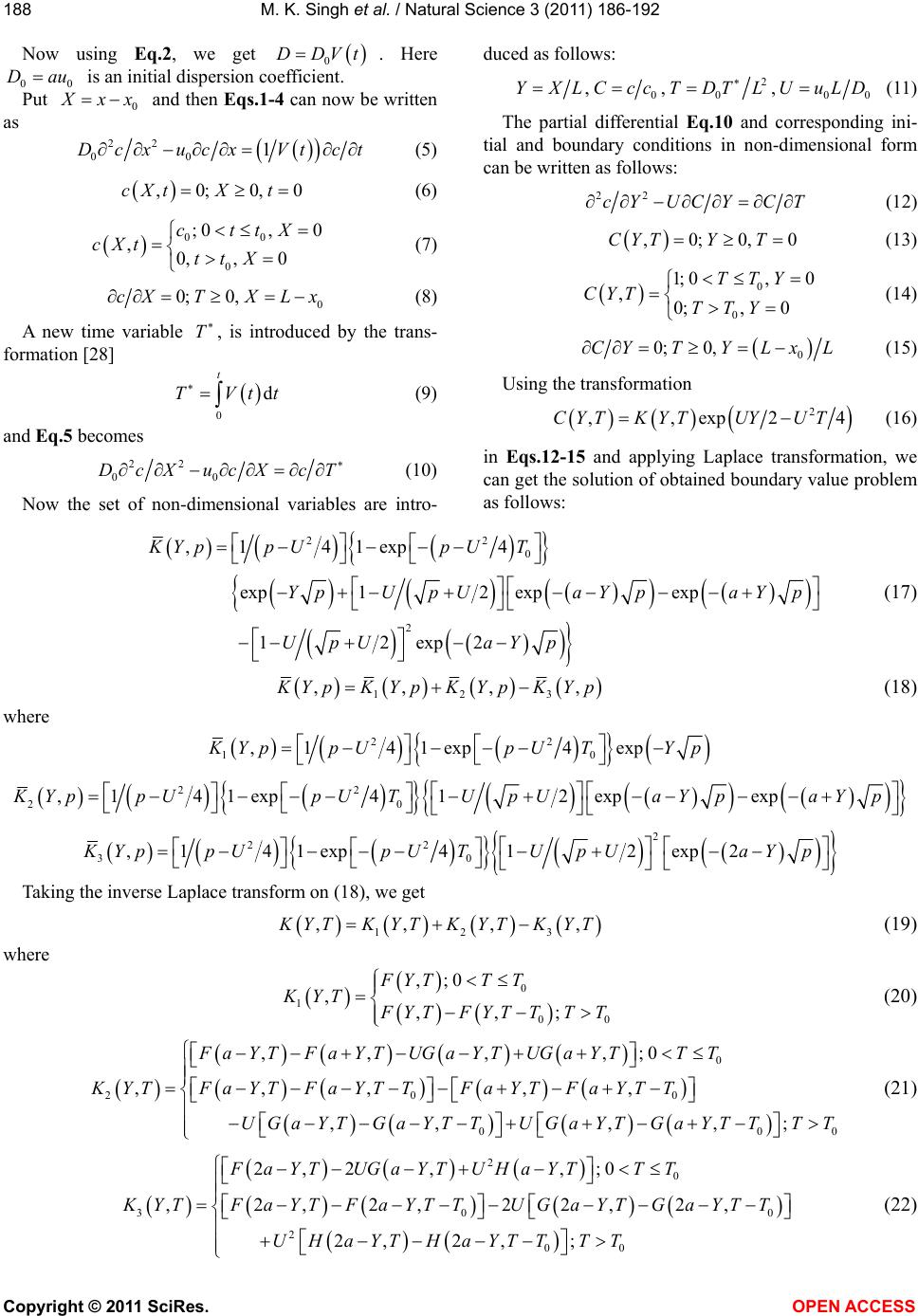 M. K. Singh et al. / Natural Science 3 (2011) 186-192 Copyright © 2011 SciRes. OPEN ACCESS 188 Now using Eq.2, we get 0 DDVt. Here 00 Dau is an initial dispersion coefficient. Put 0 xx and then Eqs.1-4 can now be written as 22 00 1Dcx ucxVtct (5) ,0; 0,0cXtX t (6) 00 0 ;0, 0 ,0,, 0 cttX cXt ttX (7) 0 0; 0,cXTX Lx (8) A new time variable T, is introduced by the trans- formation [28] 0 d t TVtt (9) and Eq.5 becomes 22 00 DcX ucXcT (10) Now the set of non-dimensional variables are intro- duced as follows: 2 00 00 ,, ,YXLCccTDTLUuLD (11) The partial differential Eq.10 and corresponding ini- tial and boundary conditions in non-dimensional form can be written as follows: 22 cY UCYCT (12) ,0;0,0CYTY T (13) 0 0 1; 0,0 ,0;, 0 TTY CYT TTY (14) 0 0; 0,CYTYLx L (15) Using the transformation 2 ,,exp24CYTKYTUYUT (16) in Eqs.12-15 and applying Laplace transformation, we can get the solution of obtained boundary value problem as follows: 22 0 2 ,1 41exp4 exp12 expexp 12exp2 KYppUp UT YpUpUaYpaY p UpU aYp (17) 123 ,,,, YpK YpKYpKYp (18) where 22 10 ,141 exp4exp YppUpUTY p 22 20 ,141 exp412expexpKYppUpUTUpUaY paY p 2 22 30 ,141 exp412exp2KYppUpUTUpUaY p Taking the inverse Laplace transform on (18), we get 123 ,,,, YTK YTKYTKYT (19) where 0 1 00 ,;0 ,,,; FYTT T KYT YTFYTTTT (20) 0 200 000 ,, , ,;0 ,,, ,, ,, ,,; FaYTF aYTUG aYTUG aYTTT KYTFaYT FaYTTFaYT FaYTT UGaYT GaYTTUGaYT GaYTTTT (21) 2 0 300 2 00 2,2 ,,;0 ,2,2,2 2,2, 2, 2, ; Fa YTUGa YTUHa YTTT YTFa YTFa YTTUGaYTGa YTT U H aYTH aYTTTT (22) 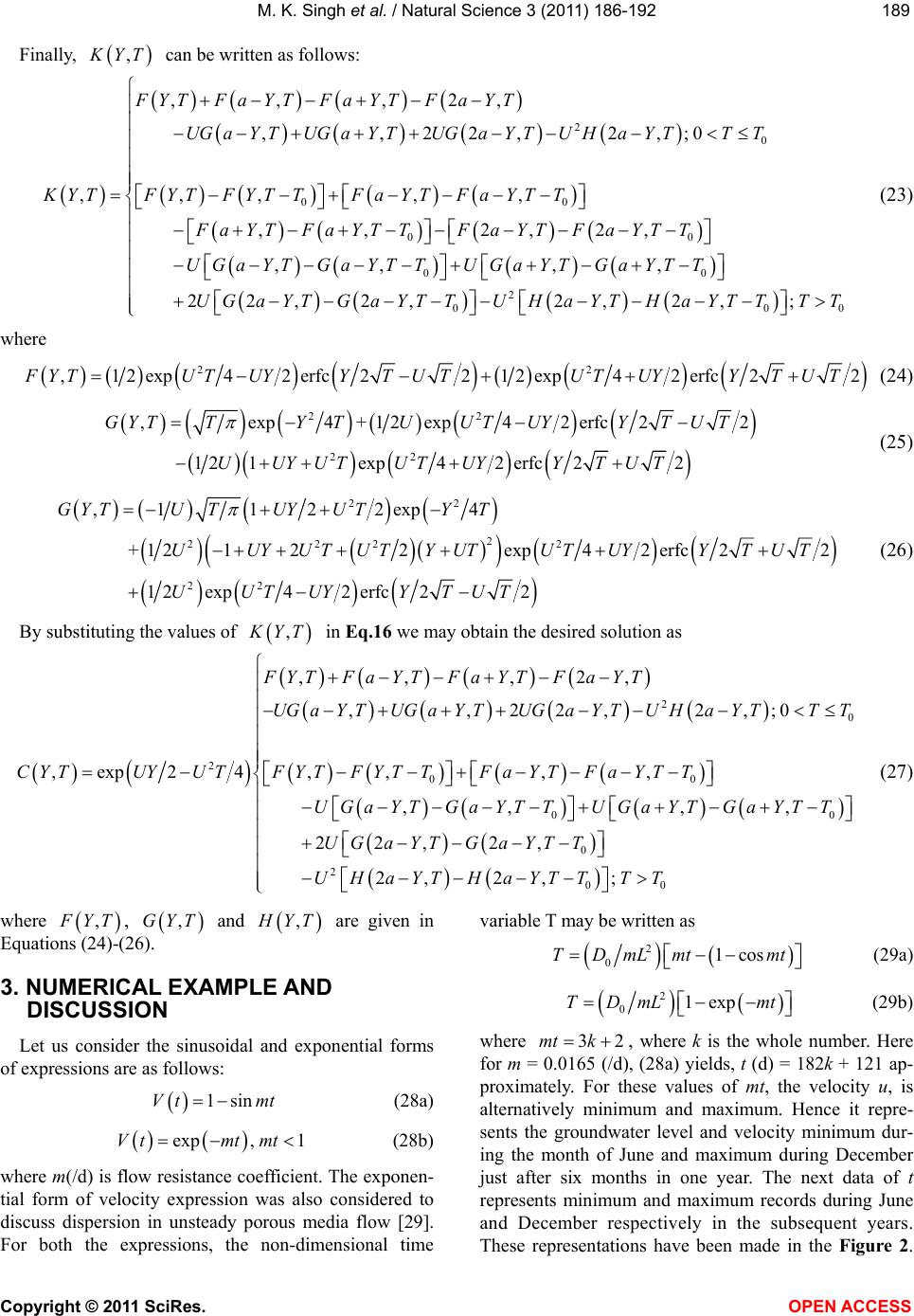 M. K. Singh et al. / Natural Science 3 (2011) 186-192 Copyright © 2011 SciRes. OPEN ACCESS 189189 Finally, , YT can be written as follows: 2 0 00 00 00 ,,,2, ,,22,2,;0 ,,,, , ,,2,2, ,, ,, FYTFaYTFaYTFaYT UGaY TUGaY TUGaYTUHaY TTT K YTF YTFYTTFaYTF aYTT Fa YTFa YTTFa YTFa YTT UGaYT GaYTTUGaYT GaYTT 2 000 22, 2,2,2,;UG aYTG aYTTUHaYTHaYTTT T (23) where 2 2 ,12 exp42 erfc2212 exp42 erfc22FYT UTUYYTUTUTUYYTUT (24) 22 22 ,exp4+12exp42erfc22 121exp42 erfc22 GYTTYTUUTUYYTU T UUYUT UTUYYTUT (25) 22 2 222 2 22 ,1 122exp4 +1 2122exp42erfc22 1 2exp42erfc22 GYTUTUYUTYT UUYUTUTYUTU TUYYTUT UUTUY YTUT (26) By substituting the values of , YT in Eq.16 we may obtain the desired solution as 2 0 2 00 00 0 2 ,,,2, ,,22,2,;0 ,exp 24,,,, ,, ,, 22, 2, 2, FYTFaYTFaYTFaYT UGaY TUGaY TUGaY TUHaY TTT CYTUYUTFYTFYTTFaYTFaYTT UGaYT GaYTTUGaYT GaYTT UG aYTG aYTT UHaY 00 2, ;THaYTT TT (27) where , YT , ,GYT and , YT are given in Equations (24)-(26). 3. NUMERICAL EXAMPLE AND DISCUSSION Let us consider the sinusoidal and exponential forms of expressions are as follows: 1sinVtmt (28a) exp, 1V tmtmt (28b) where m(/d) is flow resistance coefficient. The exponen- tial form of velocity expression was also considered to discuss dispersion in unsteady porous media flow [29]. For both the expressions, the non-dimensional time variable T may be written as 2 01cosTD mLmtmt (29a) 2 01expTD mLmt (29b) where 32mt k , where k is the whole number. Here for m = 0.0165 (/d), (28a) yields, t (d) = 182k + 121 ap- proximately. For these values of mt, the velocity u, is alternatively minimum and maximum. Hence it repre- sents the groundwater level and velocity minimum dur- ing the month of June and maximum during December just after six months in one year. The next data of t represents minimum and maximum records during June and December respectively in the subsequent years. These representations have been made in the Figure 2. 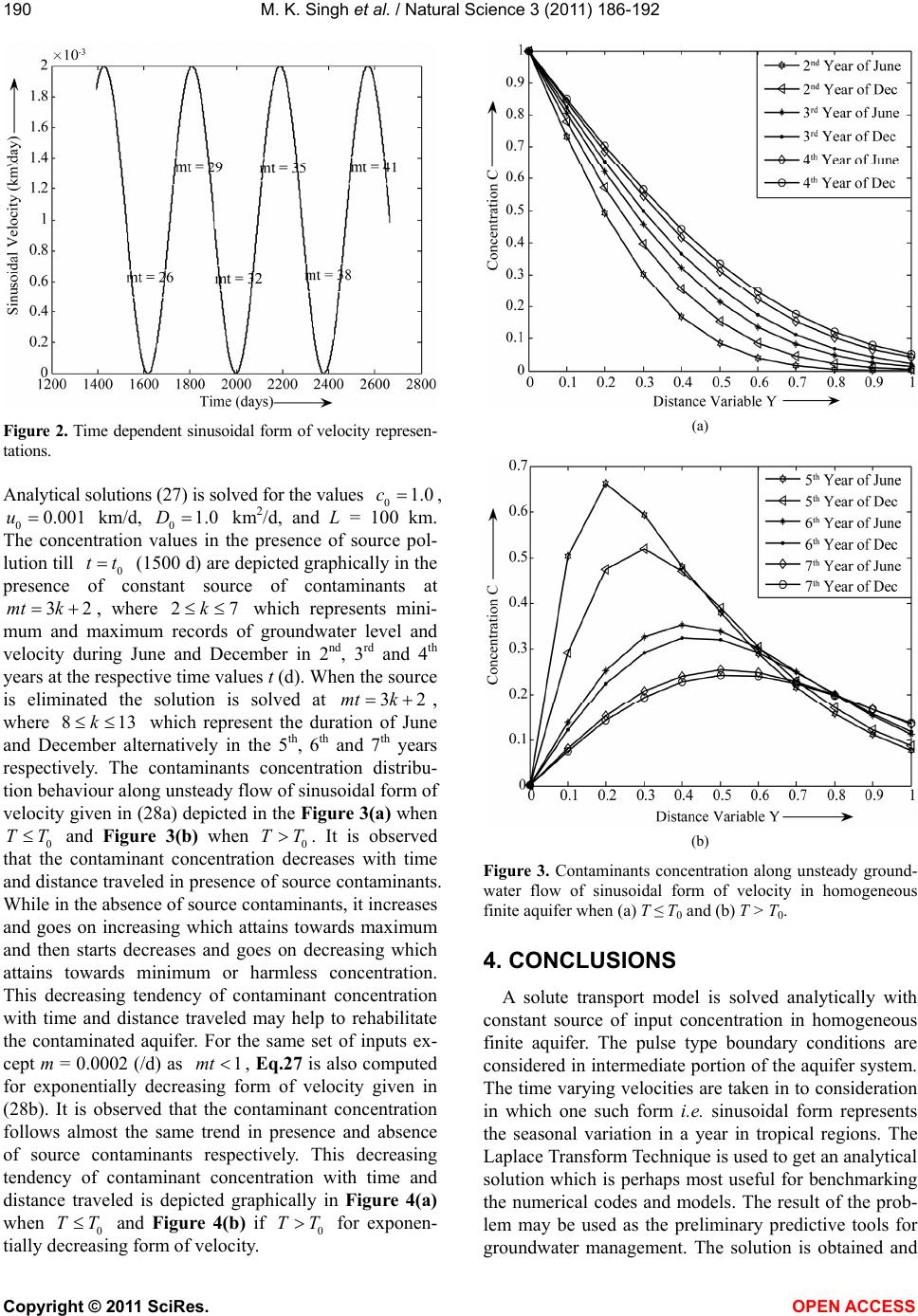 M. K. Singh et al. / Natural Science 3 (2011) 186-192 Copyright © 2011 SciRes. OPEN ACCESS 190 Figure 2. Time dependent sinusoidal form of velocity represen- tations. Analytical solutions (27) is solved for the values 01.0c , 00.001u km/d, 01.0D km2/d, and L = 100 km. The concentration values in the presence of source pol- lution till 0 tt (1500 d) are depicted graphically in the presence of constant source of contaminants at 32mt k, where 27k which represents mini- mum and maximum records of groundwater level and velocity during June and December in 2nd, 3rd and 4th years at the respective time values t (d). When the source is eliminated the solution is solved at 32mt k , where 813k which represent the duration of June and December alternatively in the 5th, 6th and 7th years respectively. The contaminants concentration distribu- tion behaviour along unsteady flow of sinusoidal form of velocity given in (28a) depicted in the Figure 3(a) when 0 TT and Figure 3(b) when 0 TT. It is observed that the contaminant concentration decreases with time and distance traveled in presence of source contaminants. While in the absence of source contaminants, it increases and goes on increasing which attains towards maximum and then starts decreases and goes on decreasing which attains towards minimum or harmless concentration. This decreasing tendency of contaminant concentration with time and distance traveled may help to rehabilitate the contaminated aquifer. For the same set of inputs ex- cept m = 0.0002 (/d) as 1mt , Eq.27 is also computed for exponentially decreasing form of velocity given in (28b). It is observed that the contaminant concentration follows almost the same trend in presence and absence of source contaminants respectively. This decreasing tendency of contaminant concentration with time and distance traveled is depicted graphically in Figure 4(a) when 0 TT and Figure 4(b) if 0 TT for exponen- tially decreasing form of velocity. (a) (b) Figure 3. Contaminants concentration along unsteady ground- water flow of sinusoidal form of velocity in homogeneous finite aquifer when (a) T ≤ T0 and (b) T > T0. 4. CONCLUSIONS A solute transport model is solved analytically with constant source of input concentration in homogeneous finite aquifer. The pulse type boundary conditions are considered in intermediate portion of the aquifer system. The time varying velocities are taken in to consideration in which one such form i.e. sinusoidal form represents the seasonal variation in a year in tropical regions. The Laplace Transform Technique is used to get an analytical solution which is perhaps most useful for benchmarking the numerical codes and models. The result of the prob- lem may be used as the preliminary predictive tools for groundwater management. The solution is obtained and 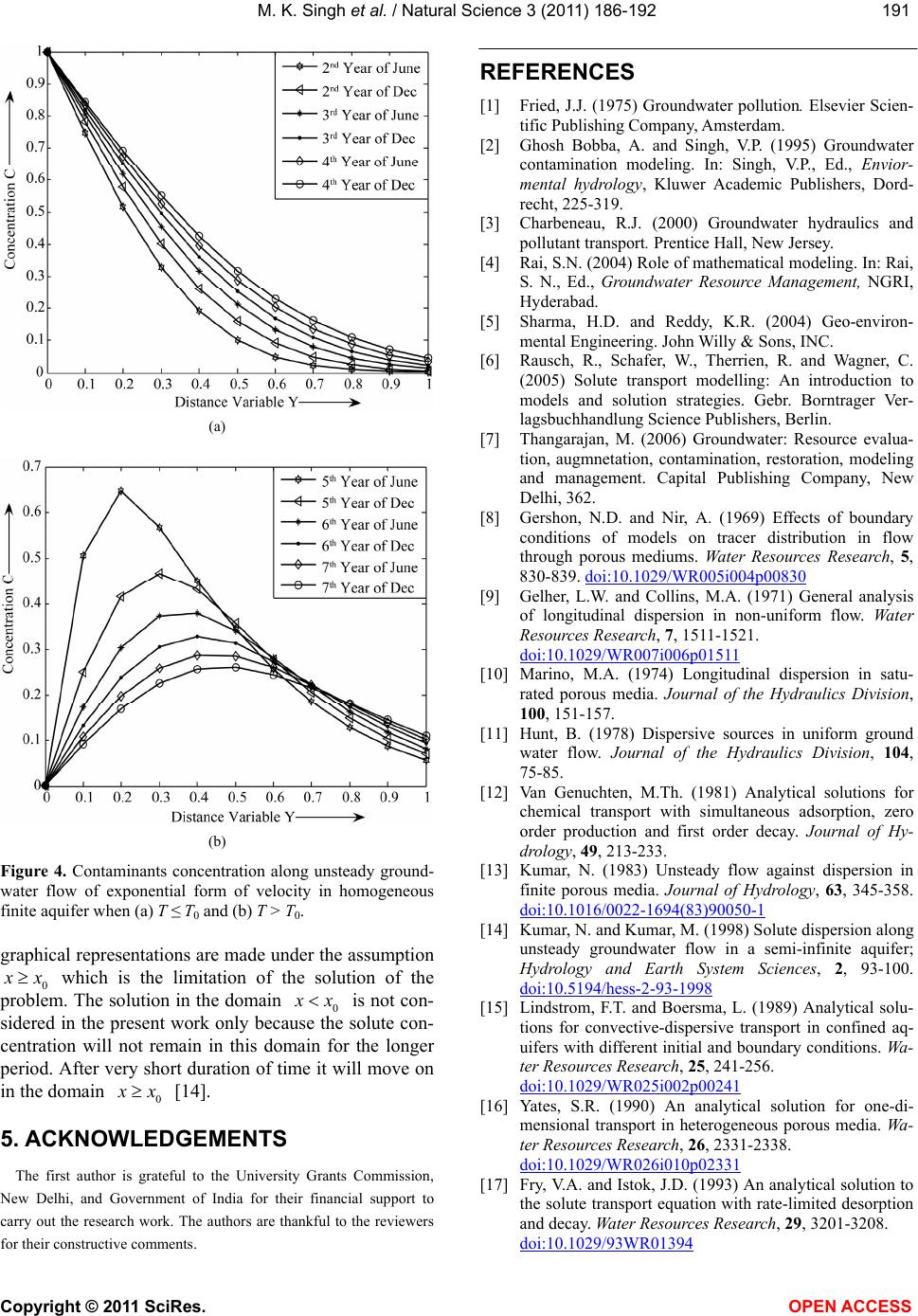 M. K. Singh et al. / Natural Science 3 (2011) 186-192 Copyright © 2011 SciRes. OPEN ACCESS 191191 (a) (b) Figure 4. Contaminants concentration along unsteady ground- water flow of exponential form of velocity in homogeneous finite aquifer when (a) T ≤ T0 and (b) T > T0. graphical representations are made under the assumption 0 x which is the limitation of the solution of the problem. The solution in the domain 0 x is not con- sidered in the present work only because the solute con- centration will not remain in this domain for the longer period. After very short duration of time it will move on in the domain 0 x [14]. 5. ACKNOWLEDGEMENTS The first author is grateful to the University Grants Commission, New Delhi, and Government of India for their financial support to carry out the research work. The authors are thankful to the reviewers for their constructive comments. REFERENCES [1] Fried, J.J. (1975) Groundwater pollution. Elsevier Scien- tific Publishing Company, Amsterdam. [2] Ghosh Bobba, A. and Singh, V.P. (1995) Groundwater contamination modeling. In: Singh, V.P., Ed., Envior- mental hydrology, Kluwer Academic Publishers, Dord- recht, 225-319. [3] Charbeneau, R.J. (2000) Groundwater hydraulics and pollutant transport. Prentice Hall, New Jersey. [4] Rai, S.N. (2004) Role of mathematical modeling. In: Rai, S. N., Ed., Groundwater Resource Management, NGRI, Hyderabad. [5] Sharma, H.D. and Reddy, K.R. (2004) Geo-environ- mental Engineering. John Willy & Sons, INC. [6] Rausch, R., Schafer, W., Therrien, R. and Wagner, C. (2005) Solute transport modelling: An introduction to models and solution strategies. Gebr. Borntrager Ver- lagsbuchhandlung Science Publishers, Berlin. [7] Thangarajan, M. (2006) Groundwater: Resource evalua- tion, augmnetation, contamination, restoration, modeling and management. Capital Publishing Company, New Delhi, 362. [8] Gershon, N.D. and Nir, A. (1969) Effects of boundary conditions of models on tracer distribution in flow through porous mediums. Water Resources Research, 5, 830-839. doi:10.1029/WR005i004p00830 [9] Gelher, L.W. and Collins, M.A. (1971) General analysis of longitudinal dispersion in non-uniform flow. Water Resources Research, 7, 1511-1521. doi:10.1029/WR007i006p01511 [10] Marino, M.A. (1974) Longitudinal dispersion in satu- rated porous media. Journal of the Hydraulics Division, 100, 151-157. [11] Hunt, B. (1978) Dispersive sources in uniform ground water flow. Journal of the Hydraulics Division, 104, 75-85. [12] Van Genuchten, M.Th. (1981) Analytical solutions for chemical transport with simultaneous adsorption, zero order production and first order decay. Journal of Hy- drology, 49, 213-233. [13] Kumar, N. (1983) Unsteady flow against dispersion in finite porous media. Journal of Hydrology, 63, 345-358. doi:10.1016/0022-1694(83)90050-1 [14] Kumar, N. and Kumar, M. (1998) Solute dispersion along unsteady groundwater flow in a semi-infinite aquifer; Hydrology and Earth System Sciences, 2, 93-100. doi:10.5194/hess-2-93-1998 [15] Lindstrom, F.T. and Boersma, L. (1989) Analytical solu- tions for convective-dispersive transport in confined aq- uifers with different initial and boundary conditions. Wa- ter Resources Research, 25, 241-256. doi:10.1029/WR025i002p00241 [16] Yates, S.R. (1990) An analytical solution for one-di- mensional transport in heterogeneous porous media. Wa- ter Resources Research, 26, 2331-2338. doi:10.1029/WR026i010p02331 [17] Fry, V.A. and Istok, J.D. (1993) An analytical solution to the solute transport equation with rate-limited desorption and decay. Water Resources Research, 29, 3201-3208. doi:10.1029/93WR01394 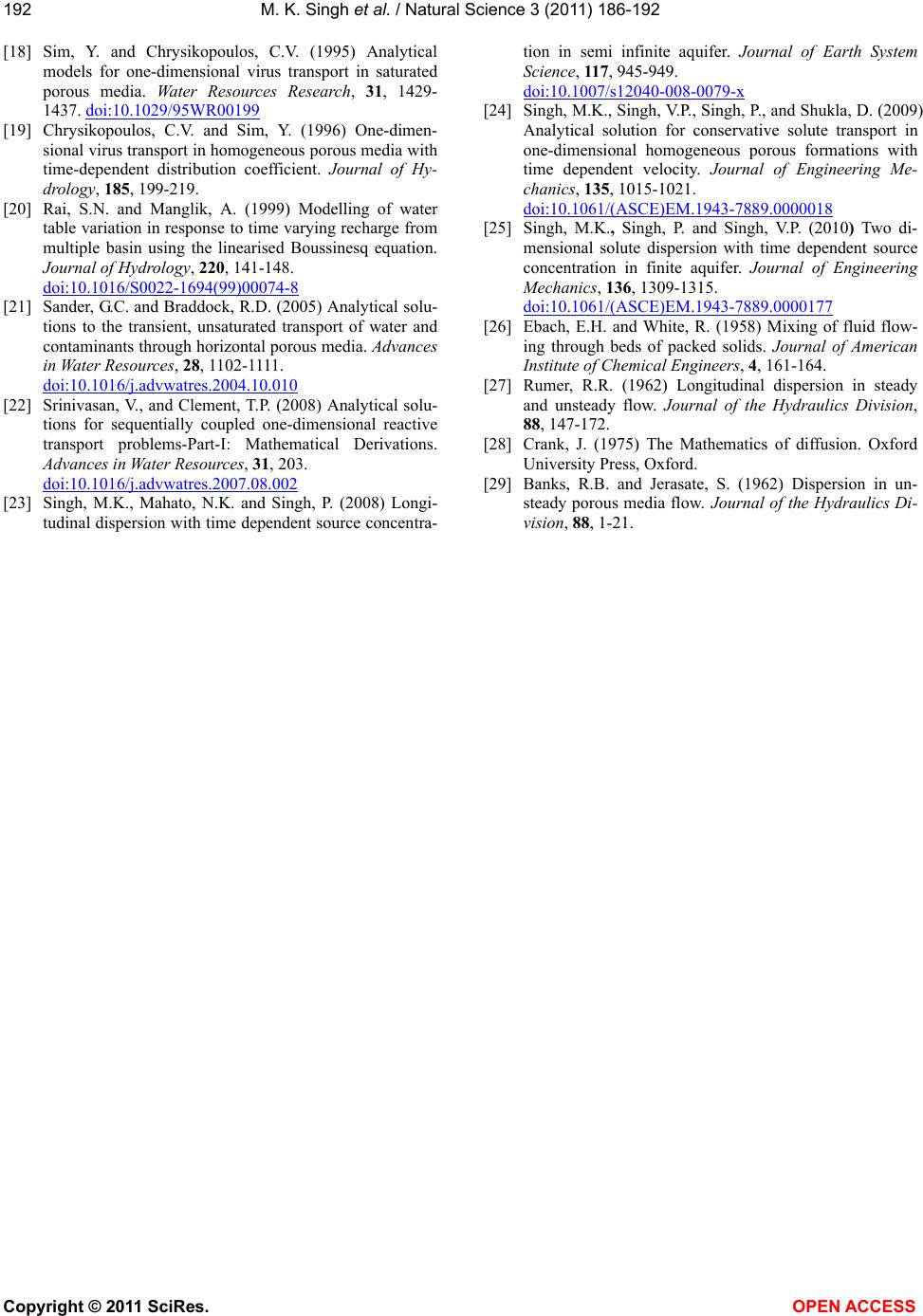 M. K. Singh et al. / Natural Science 3 (2011) 186-192 Copyright © 2011 SciRes. OPEN ACCESS 192 [18] Sim, Y. and Chrysikopoulos, C.V. (1995) Analytical models for one-dimensional virus transport in saturated porous media. Water Resources Research, 31, 1429- 1437. doi:10.1029/95WR00199 [19] Chrysikopoulos, C.V. and Sim, Y. (1996) One-dimen- sional virus transport in homogeneous porous media with time-dependent distribution coefficient. Journal of Hy- drology, 185, 199-219. [20] Rai, S.N. and Manglik, A. (1999) Modelling of water table variation in response to time varying recharge from multiple basin using the linearised Boussinesq equation. Journal of Hydrology, 220, 141-148. doi:10.1016/S0022-1694(99)00074-8 [21] Sander, G.C. and Braddock, R.D. (2005) Analytical solu- tions to the transient, unsaturated transport of water and contaminants through horizontal porous media. Advances in Water Resources, 28, 1102-1111. doi:10.1016/j.advwatres.2004.10.010 [22] Srinivasan, V., and Clement, T.P. (2008) Analytical solu- tions for sequentially coupled one-dimensional reactive transport problems-Part-I: Mathematical Derivations. Advances in Water Resources, 31, 203. doi:10.1016/j.advwatres.2007.08.002 [23] Singh, M.K., Mahato, N.K. and Singh, P. (2008) Longi- tudinal dispersion with time dependent source concentra- tion in semi infinite aquifer. Journal of Earth System Science, 117, 945-949. doi:10.1007/s12040-008-0079-x [24] Singh, M.K., Singh, V.P., Singh, P., and Shukla, D. (2009) Analytical solution for conservative solute transport in one-dimensional homogeneous porous formations with time dependent velocity. Journal of Engineering Me- chanics, 135, 1015-1021. doi:10.1061/(ASCE)EM.1943-7889.0000018 [25] Singh, M.K., Singh, P. and Singh, V.P. (2010) Two di- mensional solute dispersion with time dependent source concentration in finite aquifer. Journal of Engineering Mechanics, 136, 1309-1315. doi:10.1061/(ASCE)EM.1943-7889.0000177 [26] Ebach, E.H. and White, R. (1958) Mixing of fluid flow- ing through beds of packed solids. Journal of American Institute of Chemical Engineers, 4, 161-164. [27] Rumer, R.R. (1962) Longitudinal dispersion in steady and unsteady flow. Journal of the Hydraulics Division, 88, 147-172. [28] Crank, J. (1975) The Mathematics of diffusion. Oxford University Press, Oxford. [29] Banks, R.B. and Jerasate, S. (1962) Dispersion in un- steady porous media flow. Journal of the Hydraulics Di- vision, 88, 1-21.
|